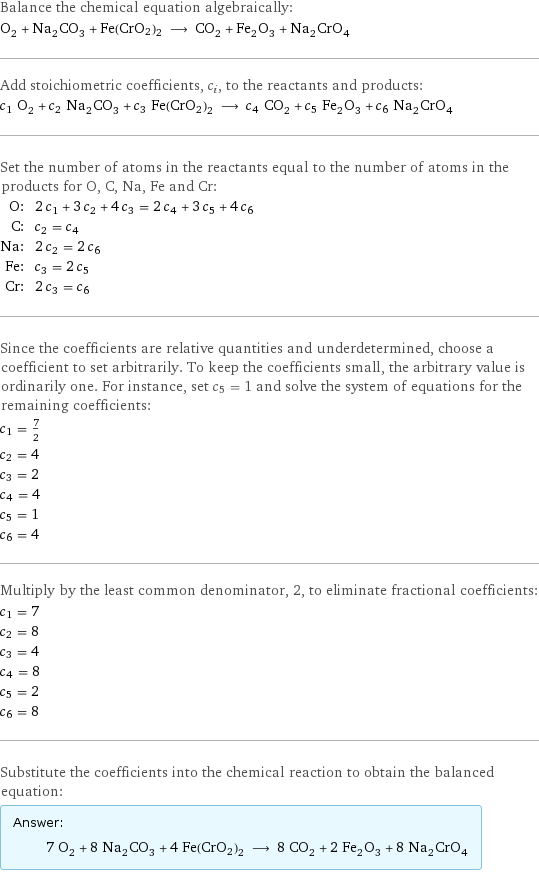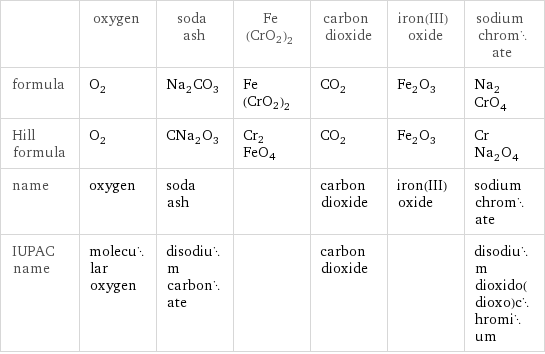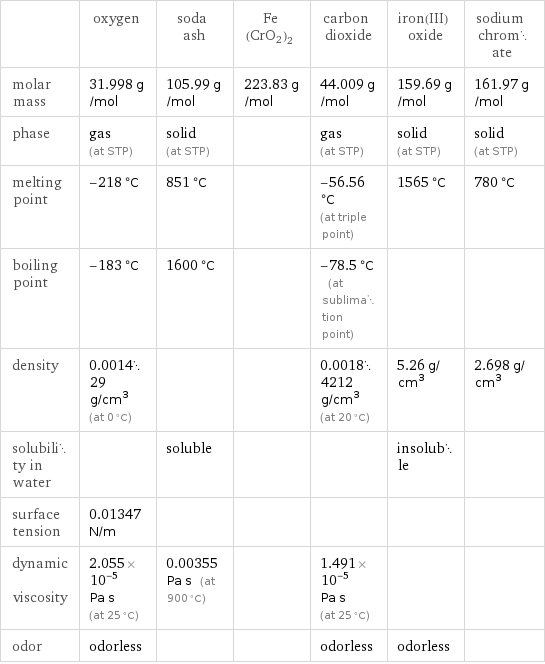Input interpretation

O_2 oxygen + Na_2CO_3 soda ash + Fe(CrO2)2 ⟶ CO_2 carbon dioxide + Fe_2O_3 iron(III) oxide + Na_2CrO_4 sodium chromate
Balanced equation

Balance the chemical equation algebraically: O_2 + Na_2CO_3 + Fe(CrO2)2 ⟶ CO_2 + Fe_2O_3 + Na_2CrO_4 Add stoichiometric coefficients, c_i, to the reactants and products: c_1 O_2 + c_2 Na_2CO_3 + c_3 Fe(CrO2)2 ⟶ c_4 CO_2 + c_5 Fe_2O_3 + c_6 Na_2CrO_4 Set the number of atoms in the reactants equal to the number of atoms in the products for O, C, Na, Fe and Cr: O: | 2 c_1 + 3 c_2 + 4 c_3 = 2 c_4 + 3 c_5 + 4 c_6 C: | c_2 = c_4 Na: | 2 c_2 = 2 c_6 Fe: | c_3 = 2 c_5 Cr: | 2 c_3 = c_6 Since the coefficients are relative quantities and underdetermined, choose a coefficient to set arbitrarily. To keep the coefficients small, the arbitrary value is ordinarily one. For instance, set c_5 = 1 and solve the system of equations for the remaining coefficients: c_1 = 7/2 c_2 = 4 c_3 = 2 c_4 = 4 c_5 = 1 c_6 = 4 Multiply by the least common denominator, 2, to eliminate fractional coefficients: c_1 = 7 c_2 = 8 c_3 = 4 c_4 = 8 c_5 = 2 c_6 = 8 Substitute the coefficients into the chemical reaction to obtain the balanced equation: Answer: | | 7 O_2 + 8 Na_2CO_3 + 4 Fe(CrO2)2 ⟶ 8 CO_2 + 2 Fe_2O_3 + 8 Na_2CrO_4
Structures

+ + Fe(CrO2)2 ⟶ + +
Names

oxygen + soda ash + Fe(CrO2)2 ⟶ carbon dioxide + iron(III) oxide + sodium chromate
Equilibrium constant
![Construct the equilibrium constant, K, expression for: O_2 + Na_2CO_3 + Fe(CrO2)2 ⟶ CO_2 + Fe_2O_3 + Na_2CrO_4 Plan: • Balance the chemical equation. • Determine the stoichiometric numbers. • Assemble the activity expression for each chemical species. • Use the activity expressions to build the equilibrium constant expression. Write the balanced chemical equation: 7 O_2 + 8 Na_2CO_3 + 4 Fe(CrO2)2 ⟶ 8 CO_2 + 2 Fe_2O_3 + 8 Na_2CrO_4 Assign stoichiometric numbers, ν_i, using the stoichiometric coefficients, c_i, from the balanced chemical equation in the following manner: ν_i = -c_i for reactants and ν_i = c_i for products: chemical species | c_i | ν_i O_2 | 7 | -7 Na_2CO_3 | 8 | -8 Fe(CrO2)2 | 4 | -4 CO_2 | 8 | 8 Fe_2O_3 | 2 | 2 Na_2CrO_4 | 8 | 8 Assemble the activity expressions accounting for the state of matter and ν_i: chemical species | c_i | ν_i | activity expression O_2 | 7 | -7 | ([O2])^(-7) Na_2CO_3 | 8 | -8 | ([Na2CO3])^(-8) Fe(CrO2)2 | 4 | -4 | ([Fe(CrO2)2])^(-4) CO_2 | 8 | 8 | ([CO2])^8 Fe_2O_3 | 2 | 2 | ([Fe2O3])^2 Na_2CrO_4 | 8 | 8 | ([Na2CrO4])^8 The equilibrium constant symbol in the concentration basis is: K_c Mulitply the activity expressions to arrive at the K_c expression: Answer: | | K_c = ([O2])^(-7) ([Na2CO3])^(-8) ([Fe(CrO2)2])^(-4) ([CO2])^8 ([Fe2O3])^2 ([Na2CrO4])^8 = (([CO2])^8 ([Fe2O3])^2 ([Na2CrO4])^8)/(([O2])^7 ([Na2CO3])^8 ([Fe(CrO2)2])^4)](../image_source/d5981d553dac7d9cc508c3eadd8d62f0.png)
Construct the equilibrium constant, K, expression for: O_2 + Na_2CO_3 + Fe(CrO2)2 ⟶ CO_2 + Fe_2O_3 + Na_2CrO_4 Plan: • Balance the chemical equation. • Determine the stoichiometric numbers. • Assemble the activity expression for each chemical species. • Use the activity expressions to build the equilibrium constant expression. Write the balanced chemical equation: 7 O_2 + 8 Na_2CO_3 + 4 Fe(CrO2)2 ⟶ 8 CO_2 + 2 Fe_2O_3 + 8 Na_2CrO_4 Assign stoichiometric numbers, ν_i, using the stoichiometric coefficients, c_i, from the balanced chemical equation in the following manner: ν_i = -c_i for reactants and ν_i = c_i for products: chemical species | c_i | ν_i O_2 | 7 | -7 Na_2CO_3 | 8 | -8 Fe(CrO2)2 | 4 | -4 CO_2 | 8 | 8 Fe_2O_3 | 2 | 2 Na_2CrO_4 | 8 | 8 Assemble the activity expressions accounting for the state of matter and ν_i: chemical species | c_i | ν_i | activity expression O_2 | 7 | -7 | ([O2])^(-7) Na_2CO_3 | 8 | -8 | ([Na2CO3])^(-8) Fe(CrO2)2 | 4 | -4 | ([Fe(CrO2)2])^(-4) CO_2 | 8 | 8 | ([CO2])^8 Fe_2O_3 | 2 | 2 | ([Fe2O3])^2 Na_2CrO_4 | 8 | 8 | ([Na2CrO4])^8 The equilibrium constant symbol in the concentration basis is: K_c Mulitply the activity expressions to arrive at the K_c expression: Answer: | | K_c = ([O2])^(-7) ([Na2CO3])^(-8) ([Fe(CrO2)2])^(-4) ([CO2])^8 ([Fe2O3])^2 ([Na2CrO4])^8 = (([CO2])^8 ([Fe2O3])^2 ([Na2CrO4])^8)/(([O2])^7 ([Na2CO3])^8 ([Fe(CrO2)2])^4)
Rate of reaction
![Construct the rate of reaction expression for: O_2 + Na_2CO_3 + Fe(CrO2)2 ⟶ CO_2 + Fe_2O_3 + Na_2CrO_4 Plan: • Balance the chemical equation. • Determine the stoichiometric numbers. • Assemble the rate term for each chemical species. • Write the rate of reaction expression. Write the balanced chemical equation: 7 O_2 + 8 Na_2CO_3 + 4 Fe(CrO2)2 ⟶ 8 CO_2 + 2 Fe_2O_3 + 8 Na_2CrO_4 Assign stoichiometric numbers, ν_i, using the stoichiometric coefficients, c_i, from the balanced chemical equation in the following manner: ν_i = -c_i for reactants and ν_i = c_i for products: chemical species | c_i | ν_i O_2 | 7 | -7 Na_2CO_3 | 8 | -8 Fe(CrO2)2 | 4 | -4 CO_2 | 8 | 8 Fe_2O_3 | 2 | 2 Na_2CrO_4 | 8 | 8 The rate term for each chemical species, B_i, is 1/ν_i(Δ[B_i])/(Δt) where [B_i] is the amount concentration and t is time: chemical species | c_i | ν_i | rate term O_2 | 7 | -7 | -1/7 (Δ[O2])/(Δt) Na_2CO_3 | 8 | -8 | -1/8 (Δ[Na2CO3])/(Δt) Fe(CrO2)2 | 4 | -4 | -1/4 (Δ[Fe(CrO2)2])/(Δt) CO_2 | 8 | 8 | 1/8 (Δ[CO2])/(Δt) Fe_2O_3 | 2 | 2 | 1/2 (Δ[Fe2O3])/(Δt) Na_2CrO_4 | 8 | 8 | 1/8 (Δ[Na2CrO4])/(Δt) (for infinitesimal rate of change, replace Δ with d) Set the rate terms equal to each other to arrive at the rate expression: Answer: | | rate = -1/7 (Δ[O2])/(Δt) = -1/8 (Δ[Na2CO3])/(Δt) = -1/4 (Δ[Fe(CrO2)2])/(Δt) = 1/8 (Δ[CO2])/(Δt) = 1/2 (Δ[Fe2O3])/(Δt) = 1/8 (Δ[Na2CrO4])/(Δt) (assuming constant volume and no accumulation of intermediates or side products)](../image_source/0a7a140087e64868083629e072890c88.png)
Construct the rate of reaction expression for: O_2 + Na_2CO_3 + Fe(CrO2)2 ⟶ CO_2 + Fe_2O_3 + Na_2CrO_4 Plan: • Balance the chemical equation. • Determine the stoichiometric numbers. • Assemble the rate term for each chemical species. • Write the rate of reaction expression. Write the balanced chemical equation: 7 O_2 + 8 Na_2CO_3 + 4 Fe(CrO2)2 ⟶ 8 CO_2 + 2 Fe_2O_3 + 8 Na_2CrO_4 Assign stoichiometric numbers, ν_i, using the stoichiometric coefficients, c_i, from the balanced chemical equation in the following manner: ν_i = -c_i for reactants and ν_i = c_i for products: chemical species | c_i | ν_i O_2 | 7 | -7 Na_2CO_3 | 8 | -8 Fe(CrO2)2 | 4 | -4 CO_2 | 8 | 8 Fe_2O_3 | 2 | 2 Na_2CrO_4 | 8 | 8 The rate term for each chemical species, B_i, is 1/ν_i(Δ[B_i])/(Δt) where [B_i] is the amount concentration and t is time: chemical species | c_i | ν_i | rate term O_2 | 7 | -7 | -1/7 (Δ[O2])/(Δt) Na_2CO_3 | 8 | -8 | -1/8 (Δ[Na2CO3])/(Δt) Fe(CrO2)2 | 4 | -4 | -1/4 (Δ[Fe(CrO2)2])/(Δt) CO_2 | 8 | 8 | 1/8 (Δ[CO2])/(Δt) Fe_2O_3 | 2 | 2 | 1/2 (Δ[Fe2O3])/(Δt) Na_2CrO_4 | 8 | 8 | 1/8 (Δ[Na2CrO4])/(Δt) (for infinitesimal rate of change, replace Δ with d) Set the rate terms equal to each other to arrive at the rate expression: Answer: | | rate = -1/7 (Δ[O2])/(Δt) = -1/8 (Δ[Na2CO3])/(Δt) = -1/4 (Δ[Fe(CrO2)2])/(Δt) = 1/8 (Δ[CO2])/(Δt) = 1/2 (Δ[Fe2O3])/(Δt) = 1/8 (Δ[Na2CrO4])/(Δt) (assuming constant volume and no accumulation of intermediates or side products)
Chemical names and formulas

| oxygen | soda ash | Fe(CrO2)2 | carbon dioxide | iron(III) oxide | sodium chromate formula | O_2 | Na_2CO_3 | Fe(CrO2)2 | CO_2 | Fe_2O_3 | Na_2CrO_4 Hill formula | O_2 | CNa_2O_3 | Cr2FeO4 | CO_2 | Fe_2O_3 | CrNa_2O_4 name | oxygen | soda ash | | carbon dioxide | iron(III) oxide | sodium chromate IUPAC name | molecular oxygen | disodium carbonate | | carbon dioxide | | disodium dioxido(dioxo)chromium
Substance properties

| oxygen | soda ash | Fe(CrO2)2 | carbon dioxide | iron(III) oxide | sodium chromate molar mass | 31.998 g/mol | 105.99 g/mol | 223.83 g/mol | 44.009 g/mol | 159.69 g/mol | 161.97 g/mol phase | gas (at STP) | solid (at STP) | | gas (at STP) | solid (at STP) | solid (at STP) melting point | -218 °C | 851 °C | | -56.56 °C (at triple point) | 1565 °C | 780 °C boiling point | -183 °C | 1600 °C | | -78.5 °C (at sublimation point) | | density | 0.001429 g/cm^3 (at 0 °C) | | | 0.00184212 g/cm^3 (at 20 °C) | 5.26 g/cm^3 | 2.698 g/cm^3 solubility in water | | soluble | | | insoluble | surface tension | 0.01347 N/m | | | | | dynamic viscosity | 2.055×10^-5 Pa s (at 25 °C) | 0.00355 Pa s (at 900 °C) | | 1.491×10^-5 Pa s (at 25 °C) | | odor | odorless | | | odorless | odorless |
Units
